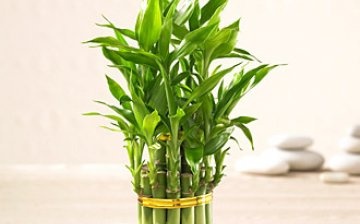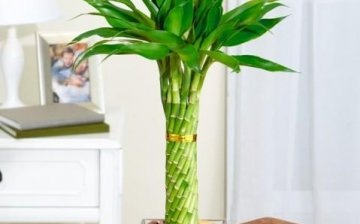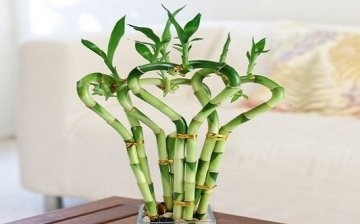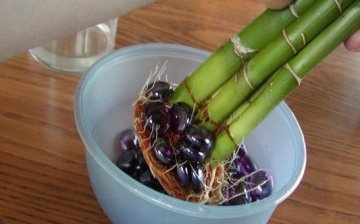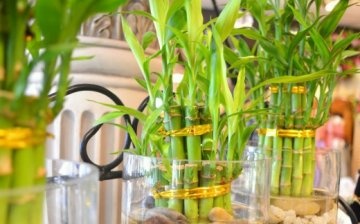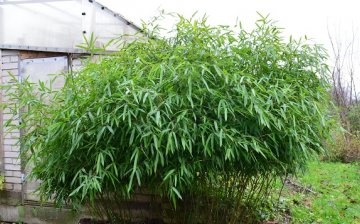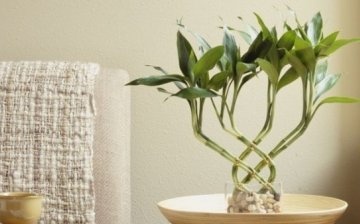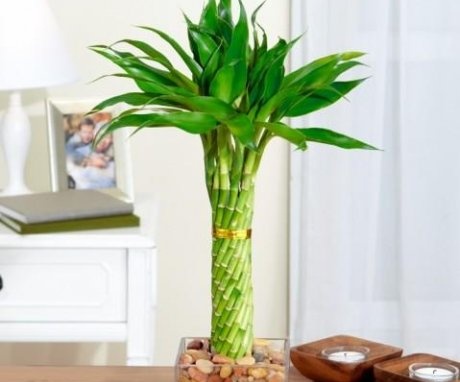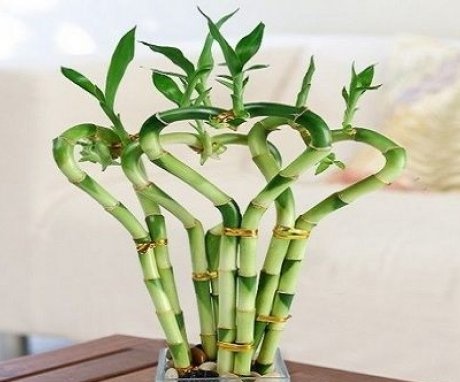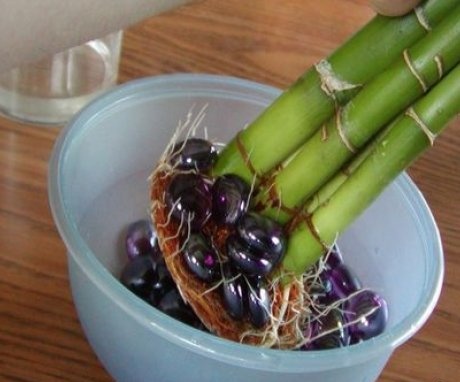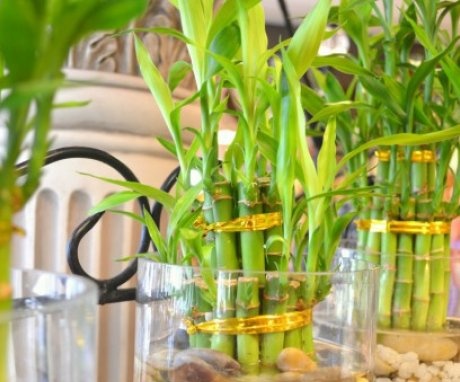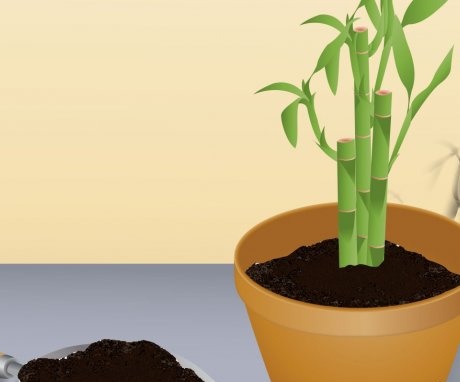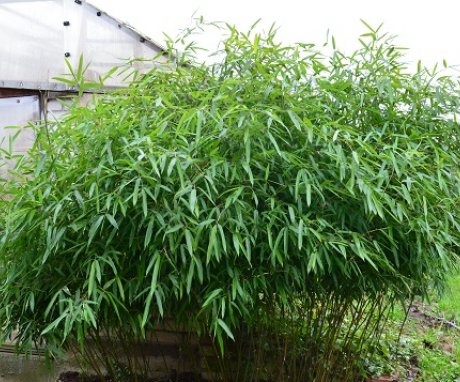How to grow bamboo: reproduction, planting and care tips
Decorative bamboo belongs to the Dracaena family. This bamboo can reach a height of 2 m. But wild bamboo grows much taller. Bamboo grows naturally in the subtropics and tropics, as well as in the mountains. Bamboos can be tree-like and herbaceous. The thickness of the trunk varies from 2-3 to 30 cm. The stem of the bamboo can branch, this makes the herbaceous bamboo look like a tree. The plant grows very vigorously and under good conditions can be about 30 meters in height. Reed bamboo is considered poisonous. Treelike bamboos have flowers once every 30 or 60 years.
Content:
- Features of the structure of the plant
- Growing conditions in the room
- Reproduction, planting and transplanting
- Taking care of indoor bamboo placed in water
- Caring for indoor bamboo planted in the ground
- Bombub in the open field: planting and care
- Diseases and pests
Features of the structure of the plant
The decorative bamboo is called Dracaena Sander. He has green stems, they can have a straw tint. It has emerald lancet-shaped leaves that grow at the top of the stem. Have indoor bamboo the stems resemble straw, as they are empty inside. Bamboo does not shed its leaves. With proper care, bamboo blooms once in a lifetime. This happens after 40 years. Flowers are small, they are collected in panicles.
In addition to green, there are many more types of bamboo with various shades: striped, gray-gray, shiny, variegated.
Plants form loose, but not very growing bushes with a large number of shoots with bright green lanceolate leaves 1.5 cm wide and up to 10 cm long. By autumn, the plants acquire a yellow-green color.
The frost-resistant bamboo variety Fargesia Murieli was named after the daughter of Ernst Wilson, who collected and sent seedlings of this species to the botanical gardens. It has yellowish green, curving stems, and the leaves are covered in wax. It blooms once every 100 years.
Growing conditions in the room
The soil should be loose, allow water to pass through well, but do not use a mixture that has a lot of peat. The mixture requires mixing 3 parts of garden soil and 1 part of medium-grained sand. In the pot, you need to make drainage from broken brick, expanded clay, clay shards, it should occupy 25% of the pot.
Temperature and lighting:
- Bamboo it is best grown at + 17-25 ° C, but it can easily withstand the heat of 30 ° C.
- Bamboo needs enough light, but it does not like direct rays of the sun, as its leaves are very delicate, they can burn.
- It is best to grow bamboo in diffused light. Put it on the east or west windowsill, you can on the southeast, southwest.
Reproduction, planting and transplanting
It is recommended to do this in the spring, due to the fact that young shoots grow on the stems, which are cut into cuttings... For the cuttings to take root, you can put them in a glass of water and wait for the roots to grow or plant them in soil that is suitable for growing bamboo.
Choose a large pot as bamboo grows very quickly in both stems and roots.
A mixture of equal parts of peat and sand is made as a soil; there must be holes for drainage in the pot. It is best to combine reproduction with a transplant. Transplant also required to do in the spring. This is done once every 2 years. Freshly transplanted bamboo and cuttings need to be looked after very carefully. They need to be watered, wiped off the foliage, loosened the soil in order to improve the access of oxygen to the rhizomes, then they will grow faster.
When you first bring a plant and plant it, it especially needs abundant watering, since in the beginning bamboo has small roots in order for them to grow, it needs a lot of water.
Transplanting indoor bamboo:
- The roots of the plant grow very actively, so it is advised to replant it annually. Take a pot with a larger volume than the previous one for transplanting.
- The pot should be deep and wide, leaving a distance of 5 cm from the stems to the edge of the pot.
- Pour drainage at the bottom of the pot, then a little soil, then plant bamboo, cover the roots with soil, tamp it a little and water it abundantly.
Taking care of indoor bamboo placed in water
It is necessary to mix the roots of the bamboo in water, then it will grow rapidly, under these conditions it grows to 0.8-2 m. But you need to remember that the water is changed once a week.
Feeding bamboo:
- Once every 2-3 months, bamboo is fed by dissolving fertilizers in water.
- Add complex mineral fertilizers into fresh water when you change it.
- If the plant lacks fertilizer, then its leaves turn yellow and fall off.
- But you cannot immediately apply top dressing, as soon as you bring the bamboo stalks home, place them in the water and wait for them to get used to room conditions, only then feed them.
Bamboo needs an equal amount of light and shade. Several stalks of bamboo are tied with a ribbon of any color and placed in a glass or other container in water. Then they put it on the windowsill. If your bamboo is very long, place it in a bucket of water or a vase and place it on the floor by the window.
Do not use regular tap water. Only soft and well-settled water is suitable. It is good to use melt water. Pour water into a plastic bottle and put it in the freezer for 2 days. Then defrost it to room temperature and you can use it, this will make the water soft. It is impossible for the water to stagnate, then the bamboo will begin to rot.
If your bamboo is in a glass vase, then put pebbles or shells on the bottom; before placing them in the vase, you need to pour boiling water over them so that there are no harmful microorganisms on them.
It is advised to pour coal into the water so that harmful bacteria do not multiply in it. Water for the care of indoor bamboo should be taken exactly the same as for glaze - thaw or rain, and change it in a vase every week. Infrequent water changes can lead to the formation of mold on root system flower.
Caring for indoor bamboo planted in the ground
When caring for bamboothat grows in the ground, you need to water it regularly. In winter, bamboo is watered more moderately, making sure that moisture does not stagnate in the ground. Mold can appear from excess moisture, so there must be holes in the pot and you need to pour broken brick or other materials on the bottom. Also bamboo is fed from time to time. Still his sprayed 3 times a week and periodically wipe the leaves from dust.
For normal growth, a pallet is placed under the pot, fine gravel is poured into it.
Then water is poured, but so that the rubble is not completely covered with water. The pot must be fixed above the pallet so that it does not have direct contact with water. It is required to prevent the soil from drying out, since in this case the bamboo leaves turn yellow and the plant dies.
The plant is fertilized from October to March - once every 3 months, and the rest of the time - after 20 days.Bamboo especially requires phosphorus and nitrogen; you can purchase a special fertilizer for dracaena for it. The air in the room must be humid. Bamboo loves fresh wind, but does not tolerate drafts. Bamboo can be pruned throughout the year. Eliminate loose stems. It is advised to take the plant out to the loggia or balcony in the summer.
Bombub in the open field: planting and care
Choose frost-resistant bamboo varieties. These are the varieties: Kuril Saza (Sasa kurilensis), Sasa Palmata Nebulosa, Phyllostachys Aureosulcata. The bamboo variety Fargesia Murielae is considered the most resistant to frost. Very often, the plant is planted near water bodies, as it loves moisture very much. It needs to be planted from March to September, so that the plant has time for rooting, and it would survive the winter period. Bamboo likes soil with an acidity of pH 6.0-6.2.
Place the bamboo pot in a container filled with water for 3-4 hours so that the roots are saturated with water.
Landing features:
- Pit for landing should be 2 times the depth and width of the bamboo roots with the ground.
- Add to the ground compost, humus.
- Pour some of this soil into the bottom of the hole and compact.
- Around the hole, it is best to dig a sheet of metal or plastic in a circle so that the roots do not grow throughout the garden.
- Put bamboo, the roots of which are soaked in water, in the hole in the center, fill in the soil, compact a little so that the roots are not damaged and there would be no air pockets.
- Pour 5 cm of soil on top. Water abundantly. Mulch the soil with a layer of 2-5 cm of leaves, peat, hay.
If you are planting bamboo in the fall, then add 20 cm of manure to the bottom of the planting pit, then 10 cm of the garden soil, then plant the plant. Then in winter the manure will decompose, and after that you will not need to feed the bamboo for 2 years.
Care Tips:
- For the first three months, water the plant very abundantly, it is impossible for the stems to dry out. Then water 2-3 times a week. It loves fertilizers with a high nitrogen content, that is, the proportion of fertilizer: 4 parts nitrogen, 3 parts phosphorus, 2 parts potassium.
- Submit top dressing in early spring. Next, fertilize the bamboo in the summer. In autumn, feed the plant: 2 parts of nitrogen, 4 parts of phosphorus, 4 parts of potassium, then it will stop growing so actively and get ready for frost. In autumn, mulch the plant with a 10 cm layer of pine bark and leaves. Trim old stems at ground level. Do this once a year.
Diseases and pests
Stems and leaves may turn yellow when:
- lack of fertilizer
- excess dressings
- too hard water for glaze
- overly chlorinated water
- heavy composition of the earth
- in the absence of drainage
If the stalk of the bamboo turns yellow, then cut off the yellowed part, and sprinkle the cut with charcoal. In this case, depending on the reason, stop feeding, or vice versa, urgently fertilize the plant.
Cut off the dried leaves, after 5 hours the cuts will dry out somewhat, then pour ash on them. Leave for 2 hours, then shake off the ash, smear the cut with a soft wax. If the stems begin to dry out, then this can happen due to bright light, move the flower to the shade.
In the heat, spider mites and thrips may appear on the leaves - spray with Fitoverm to eliminate pests.
Think that bamboogrowing in the house brings good luck, happiness, prosperity. It is grown both in ordinary soil and in water. Care behind it does not require much effort.
More information can be found in the video:



